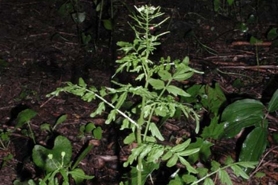Narrow leaf bittercress
(Cardamine impatiens)
Herbaceous annual or biennial in the mustard family, growing over two feet tall. Produces thousands of seeds that are ejected from slender siliques (seed pods) when mature.
Other names for this plant include:
- Common names: Bushy rockcress
- Scientific names: Cardamine impatiens var. impatiens, Cardamine impatiens var. pectinata
Classification in Wisconsin: Prohibited
- Ecological Threat
-
- Invades forests, meadows, wetlands, streamside habitats and floodplains.
- Seeds extremely resilient to harsh conditions, germinating after deep freezing and exposure to standing water.
- Seeds are easily spread by human activity.
- Identification
-
Leaves: Basal rosettes are deeply divided. Leaves contain 3-11 round-lobed leaflets. Stem leaves are opposite. Leaves and stems are hairless.
Flowers: Self-pollinating. Small white flowers bloom in late spring through late summer.
Fruits & seeds: Long slender siliques (seed pods) produce prolific amounts of seeds (over 5,500 seeds on an individual plant) that eject when mature.
Roots: Taproot with shallow fibrous rootlets.
Similar species: Narrow leaf bittercress can be mistaken for many other species in the mustard family.
- Distribution
-
Currently, there are no reports of narrow leaf bittercress in Wisconsin. Have you seen it? Send us a report.
- Control
- Mechanical
- Plants have a shallow root system making hand pulling easy and effective. Plants in flower and seed should be bagged and disposed of.
- Be sure to control plants before they mature to reduce spreading infestations.
- Clean all boots and equipment to reduce spreading seed.
- Bittercress is resistant to many types of herbicide. Spraying with glyphosate gives some longer-lasting control.
- Resources
- Sources for content:
- Minnesota Wildflowers Website
- Invasive Plant Atlas of New England



